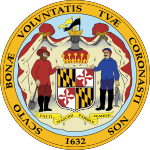
The 1792 United States presidential election was the second quadrennial presidential election. It was held from Friday, November 2, to Wednesday, December 5, 1792. Incumbent President George Washington was elected to a second term by a unanimous vote in the electoral college, while John Adams was re-elected as vice president. Washington was essentially unopposed, but Adams faced a competitive re-election against Governor George Clinton of New York.

The 2nd United States Congress, consisting of the United States Senate and the United States House of Representatives, met at Congress Hall in Philadelphia, Pennsylvania, from March 4, 1791, to March 4, 1793, during the third and fourth years of George Washington's presidency. The apportionment of seats in the House of Representatives was based on the provisions of Article I, Section 2, Clause 3 of the United States Constitution. Additional House seats were assigned to the two new states of Vermont and Kentucky. Both chambers had a Pro-Administration majority.

These are tables of congressional delegations from Maryland in the United States House of Representatives and the United States Senate.
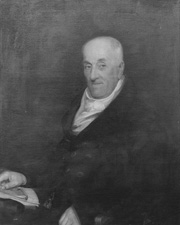
William Hindman was an American lawyer and statesman from Talbot County, Maryland. He represented Maryland in the Continental Congress, and in the federal Congress as both a Representative from the second and seventh districts, and as a U.S. Senator.
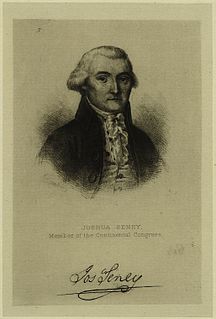
Joshua Seney was an American farmer and lawyer from Queen Anne's County, Maryland. He represented the state of Maryland in the Continental Congress, and the second district of Maryland in the House of Representatives.

The 1792–93 United States House of Representatives elections coincided with the re-election of President George Washington. While Washington ran for president as an independent, his followers formed the nation's first organized political party, the Federalist Party, whose members and sympathizers are identified as pro-Administration on this page. In response, followers of Thomas Jefferson and James Madison created the opposition Democratic-Republican Party, who are identified as anti-Administration on this page. The Federalists promoted urbanization, industrialization, mercantilism, centralized government, and a broad interpretation of the United States Constitution. In contrast, Democratic-Republicans supported the ideal of an agrarian republic made up of self-sufficient farmers and small, localized governments with limited power.

The 1790–91 United States House of Representatives elections, took place in the middle of President George Washington's first term. While formal political parties still did not exist, coalitions of pro-Washington (pro-Administration) representatives and anti-Administration representatives each gained two seats as a result of the addition of new states to the union.

The 1788–89 United States House of Representatives elections, coincided with the election of George Washington as first the president of the United States. The dates and methods of election were set by the states. Actual political parties did not yet exist, but new members of Congress were informally categorized as either "pro-Administration" or "anti-Administration".
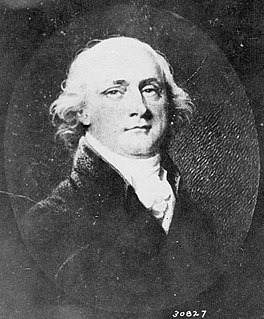
John Francis Mercer was an American lawyer, planter, and politician from Virginia and Maryland, who served as Maryland's governor, as well as terms in the Continental Congress, U.S. House of Representatives, Virginia House of Delegates, and Maryland State Assembly A Founding Father of the United States, he was a delegate to the Philadelphia Convention which wrote the U.S. Constitution.
George Dent was an American planter and politician from Maryland who served in the House of Representatives from 1793 to 1801.
Gabriel Christie was an American political leader from Perryman, Maryland.
Maryland's 8th congressional district stretches from the northern Washington, D. C., suburbs north to the Pennsylvania border. Following the 2020 redistricting cycle, it will no longer reach north into Frederick and Carroll counties, instead being concentrated solely in Montgomery County, comprising many economically and culturally diverse inner suburbs of Washington D.C. The district is currently represented by Democrat Jamie Raskin.
Maryland's 3rd congressional district comprises portions of Baltimore, Howard, Montgomery, and Anne Arundel counties, as well as a significant part of the independent city of Baltimore. The seat is currently represented by John Sarbanes, a Democrat. Landmarks in the district include Fort McHenry and the state capital, Annapolis.
Maryland's 4th congressional district comprises portions of Prince George's County and Anne Arundel County. The seat is represented by Anthony Brown, a Democrat.
Maryland's 5th congressional district comprises all of Charles, St. Mary's, and Calvert counties, as well as portions of Prince George's and Anne Arundel counties. The district is currently represented by Democrat Steny Hoyer, the current House Majority Leader.
Thomas Holdsworth Blake was an American politician who served as a United States Representative from Indiana from 1827 to 1829.

The 1789 United States House of Representatives elections in Maryland were held from December 15, 1788, to January 10, 1789, to elect the six U.S. representatives from the state of Maryland, one from each of the state's six congressional districts. The elections coincided with the 1788–89 U.S. presidential election , as well as other elections to the House of Representatives, elections to the United States Senate and various state and local elections.

A special election was held in Maryland's 2nd congressional district on January 7, 1793, to fill a vacancy left by the resignation of Joshua Seney (A) on December 6, 1792, to accept a judicial appointment.

The 1956 United States presidential election in Maryland took place on November 6, 1956, as part of the 1956 United States presidential election. State voters chose nine representatives, or electors, to the Electoral College, who voted for president and vice president.
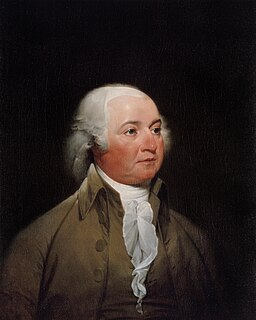
The 1792 United States presidential election in Maryland took place on an unknown date in 1792, as part of the 1792 presidential election. Voters chose eight representatives, or electors to the Electoral College, who voted for President and Vice President.
